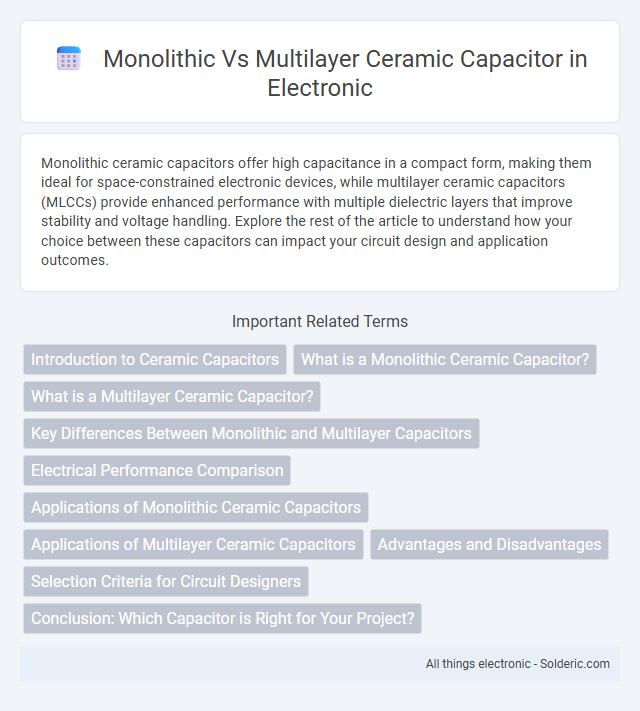Monolithic ceramic capacitors offer high capacitance in a compact form, making them ideal for space-constrained electronic devices, while multilayer ceramic capacitors (MLCCs) provide enhanced performance with multiple dielectric layers that improve stability and voltage handling. Explore the rest of the article to understand how your choice between these capacitors can impact your circuit design and application outcomes.
Comparison Table
| Feature | Monolithic Ceramic Capacitor | Multilayer Ceramic Capacitor (MLCC) |
|---|---|---|
| Construction | Single layer ceramic dielectric | Multiple ceramic dielectric layers stacked |
| Capacitance Range | Typically low, < 100 pF | Wide range, from pF to several uF |
| Size | Larger for equivalent capacitance | Compact, smaller size for higher capacitance |
| Voltage Rating | Higher voltage tolerance (up to kV) | Moderate voltage rating (tens to hundreds of volts) |
| Applications | RF circuits, precision filtering | General purpose, decoupling, bypassing |
| Cost | Higher per capacitance unit | Cost-effective for mass production |
| Reliability | High reliability, stable under voltage and temperature | Good reliability, sensitive to mechanical stress |
Introduction to Ceramic Capacitors
Monolithic ceramic capacitors consist of a single ceramic body with multiple internal electrodes, offering compact size and high reliability for general electronic applications. Multilayer ceramic capacitors (MLCCs) feature multiple stacked ceramic layers separated by internal electrodes, providing higher capacitance values and improved performance in high-frequency circuits. Both types utilize ceramic dielectric materials, influencing capacitance stability, temperature characteristics, and voltage ratings.
What is a Monolithic Ceramic Capacitor?
A Monolithic Ceramic Capacitor (MLCC) is a compact, multilayer capacitor constructed from alternating layers of ceramic dielectric and metal electrodes, offering high capacitance in a small form factor. These capacitors feature excellent electrical characteristics such as low inductance and high insulation resistance, making them ideal for high-frequency applications and surface-mount technology (SMT). Your electronic designs benefit from MLCCs due to their reliability, stability, and ability to operate efficiently across a wide temperature range.
What is a Multilayer Ceramic Capacitor?
A Multilayer Ceramic Capacitor (MLCC) is a compact electronic component consisting of multiple layers of ceramic dielectric material separated by metal electrodes, providing high capacitance in a small size. This design allows MLCCs to handle higher voltages and offer lower equivalent series resistance (ESR) compared to monolithic ceramic capacitors, making them ideal for high-frequency and high-reliability applications. MLCCs are widely used in automotive, telecommunications, and consumer electronics due to their stability, reliability, and ability to withstand thermal and mechanical stress.
Key Differences Between Monolithic and Multilayer Capacitors
Monolithic ceramic capacitors consist of a single ceramic layer, offering simple structure, lower cost, and stable performance at high frequencies. Multilayer ceramic capacitors (MLCCs) feature multiple alternating ceramic and electrode layers, providing higher capacitance values and improved voltage endurance in a compact form factor. Your choice between monolithic and multilayer capacitors depends on the required capacitance, voltage rating, and application-specific performance demands.
Electrical Performance Comparison
Monolithic ceramic capacitors exhibit lower equivalent series resistance (ESR) and inductance, enabling superior high-frequency performance and stable capacitance over a broad temperature range. Multilayer ceramic capacitors (MLCCs) offer higher capacitance values and voltage ratings due to their stacked dielectric layers, but they may experience greater dielectric absorption and microphonic effects. In applications requiring low loss and high precision, monolithic capacitors outperform MLCCs, whereas MLCCs excel in compactness and energy storage efficiency.
Applications of Monolithic Ceramic Capacitors
Monolithic ceramic capacitors are widely used in high-frequency applications such as RF circuits, signal processing, and power supply filtering due to their low equivalent series resistance (ESR) and compact size. They excel in decoupling and bypass applications on printed circuit boards (PCBs) for smartphones, computers, and automotive electronics. Your designs benefit from their reliability and stability in environments requiring consistent capacitance over a broad temperature range.
Applications of Multilayer Ceramic Capacitors
Multilayer ceramic capacitors (MLCCs) are extensively used in high-frequency electronic devices, including smartphones, laptops, and automotive electronics, due to their high capacitance and small size. They excel in decoupling and filtering applications in power supplies, ensuring stable voltage levels in integrated circuits. MLCCs are also critical in RF circuits, automotive sensors, and medical devices where reliability and performance under varying environmental conditions are essential.
Advantages and Disadvantages
Monolithic ceramic capacitors offer high capacitance in a compact size with lower equivalent series resistance, making them ideal for high-frequency applications, but they are prone to microcracks under mechanical stress. Multilayer ceramic capacitors (MLCCs) provide enhanced voltage ratings and greater capacitance stability over temperature changes, yet their performance may degrade due to dielectric material aging and they can be more expensive. Choosing between the two depends on specific application requirements such as size constraints, voltage tolerance, and environmental conditions.
Selection Criteria for Circuit Designers
Circuit designers select monolithic ceramic capacitors for applications demanding high volumetric efficiency and stable performance across temperature and frequency ranges. Multilayer ceramic capacitors (MLCCs) excel in high capacitance values with low equivalent series resistance (ESR), making them ideal for decoupling and filtering in compact layouts. Key factors in selection include voltage rating, capacitance tolerance, dielectric material, and operating environment to ensure reliability and circuit stability.
Conclusion: Which Capacitor is Right for Your Project?
Choosing between monolithic and multilayer ceramic capacitors depends on your project's specific requirements such as capacitance value, voltage rating, size constraints, and frequency performance. Monolithic ceramic capacitors excel in compact designs with lower capacitance needs, offering high reliability and cost-efficiency, while multilayer ceramic capacitors provide higher capacitance in small packages, making them ideal for high-frequency and high-density circuit applications. Evaluating factors like operating environment, electrical specifications, and budget will help determine the optimal capacitor type for your design.
Monolithic vs multilayer ceramic capacitor Infographic

 solderic.com
solderic.com